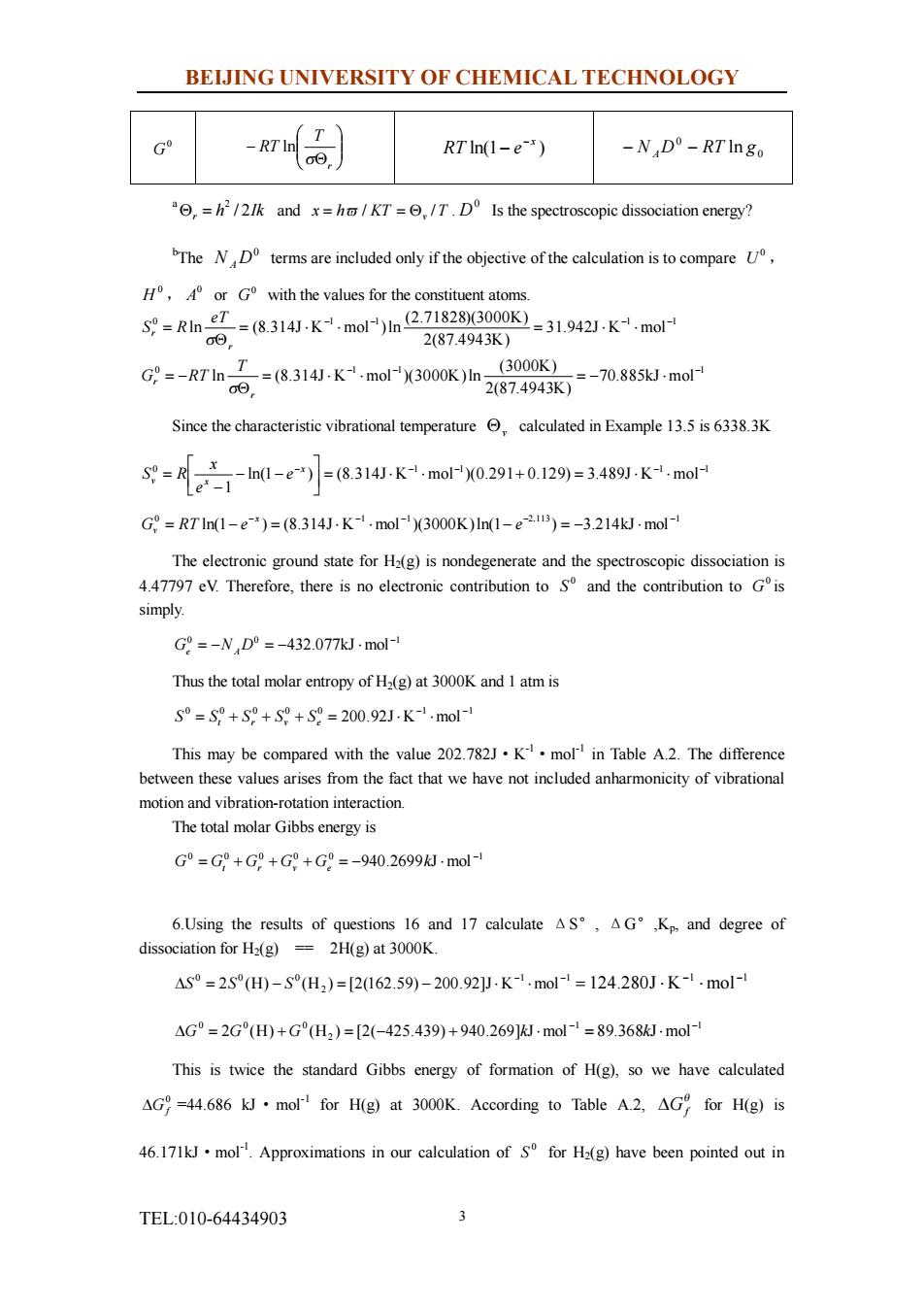正在加载图片...

BEIJING UNIVERSITY OF CHEMICAL TECHNOLOGY G RTIn(1-e-) -N,D°-RTIngo =/andx=K=/T.D Is the spectroscopic dissociation energy? The ND terms are included only if the objective of the calculation is to compare H,orwith the values for the constituent atoms 828300 K=31.942.K1.mol 2(87.4943K c-kT石-31 u-K-.X0K)恤72-nur Since the characteristic vibrational temperature calculated in Example 13.is6338.3K s=lb0-e-8314.K.moX0291+0129=348K-mo G°=RT1n1-e)=(8.314J.K-1mol-'3000K)n1-e2)=-3.214kJ-mol1 The electronic ground state for H(g)is nondegenerate and the spectroscopic dissociation is 4.47797eV.Therefore,there is no electronic contribution tos and the contribution to Gis simply. G=-N,D°=-432.077kmol- Thus the total molar entropy of H(g)at 3000K and 1atm is S=S9+S+S9+S8=200.92J-K1mol1 This may be compared with the value 202.782J.Kmol in Table A.2.The difference between these values arises from the fact that we have not included anharmonicity of vibrational The total molar is G°=G+G+G8+G8=-940.2699·mol 6.Using the results of questions 16andI7 calculate△s°,△G°,Kand degree of dissociation for Ha(g)=2H(g)at 3000K △°=2S(H-S(H,)=2162.59)-200.92-K-1.mol-=124.280J.K-1.mol- △G°=2G(H0+G(H2)=[2(-425.439)+940.269]W-mol-=89.368 J.mol- This is twice the standard Gibbs energy of formation of H(g)so we have calculated AG=44.686 kJ.mol for H(g)at 3000K.According to Table A.2.AG for H(g)is 46.171kJmol.Approximations in our calculation of S for Ha(g)have been pointed out in TEL010-64434903 3 BEIJING UNIVERSITY OF CHEMICAL TECHNOLOGY TEL:010-64434903 3 0 G ÷ ÷ ø ö ç ç è æ Q - r T RT s ln ln(1 ) x RT e - - 0 0 N D RT ln g - A - a h Ik r / 2 2 Q = and x = hv / KT = Qv /T . 0 D Is the spectroscopic dissociation energy? b The 0 NAD terms are included only if the objective of the calculation is to compare 0 U , 0 H , 0 A or 0 G with the values for the constituent atoms. 0 1 1 1 1 31.942J K mol 2(87.4943K) (2.71828)(3000K) ln (8.314J K mol )ln - - - - = × × = × × Q = r r eT S R s 0 1 1 1 70.885kJ mol 2(87.4943K) (3000K) ln (8.314J K mol )(3000K)ln - - - = × × = - × Q = - r r T G RT s Since the characteristic vibrational temperature Qv calculated in Example 13.5 is 6338.3K 0 1 1 1 1 ln(1 ) (8.314J K mol )(0.291 0.129) 3.489J K mol 1 - - - - - = × × + = × × ú û ù ê ë é - - - = x v x e e x S R 0 1 1 2.113 1 ln(1 ) (8.314J K mol )(3000K)ln(1 ) 3.214kJ mol - - - - - G = RT - e = × × - e = - × x v The electronic ground state for H2(g) is nondegenerate and the spectroscopic dissociation is 4.47797 eV. Therefore, there is no electronic contribution to 0 S and the contribution to 0 G is simply. 0 0 1 432.077kJ mol - G = -N D = - × e A Thus the total molar entropy of H2(g) at 3000K and 1 atm is 0 0 0 0 0 1 1 200.92J K mol - - = + + + = × × t r v e S S S S S This may be compared with the value 202.782J·K -1·mol-1 in Table A.2. The difference between these values arises from the fact that we have not included anharmonicity of vibrational motion and vibration-rotation interaction. The total molar Gibbs energy is 0 0 0 0 0 1 940.2699 J mol - G = G + G + G + G = - k × t r v e 6.Using the results of questions 16 and 17 calculate ΔS°, ΔG°,Kp, and degree of dissociation for H2(g) == 2H(g) at 3000K. 1 1 2 0 0 0 2 (H) (H ) [2(162.59) 200.92]J K mol - - DS = S - S = - × × 1 1 124.280J K mol - - = × × 1 2 0 0 0 2 (H) (H ) [2( 425.439) 940.269] J mol - DG = G + G = - + k × 1 89.368 J mol- = k × This is twice the standard Gibbs energy of formation of H(g), so we have calculated 0 DGf =44.686 kJ·mol-1 for H(g) at 3000K. According to Table A.2, q DGf for H(g) is 46.171kJ·mol-1 . Approximations in our calculation of 0 S for H2(g) have been pointed out in